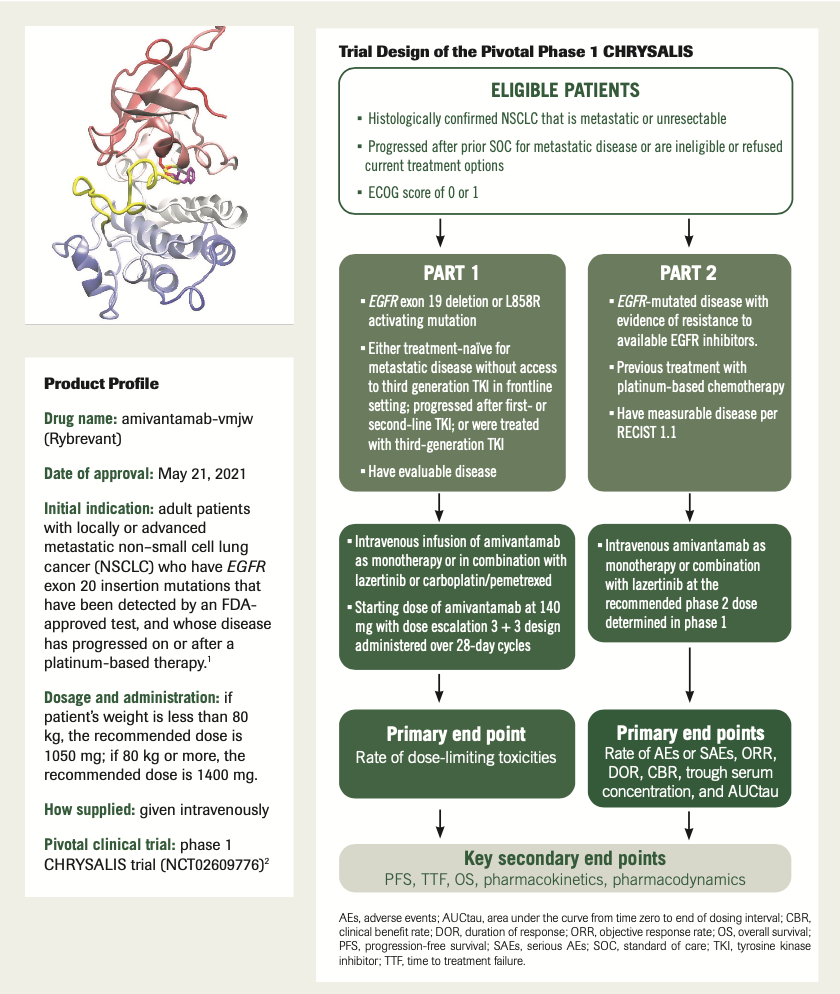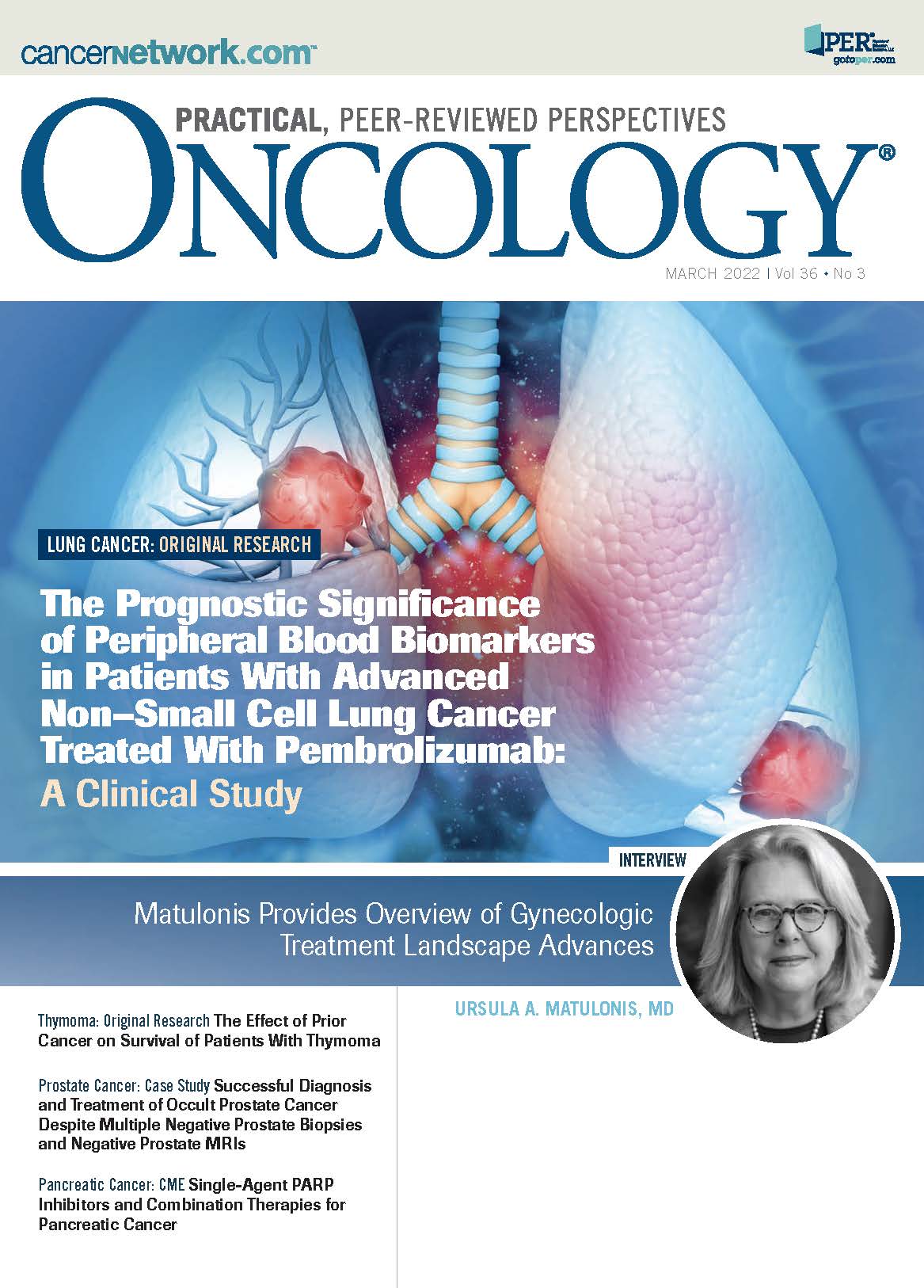Expert Commentary on the Product Profile of Amivantamab-vmjw
In an interview with ONCOLOGY®, Evan B. Bryson, PharmD, BCOP, offers a comprehensive review of real-world treatment considerations of amivantamab as therapy for patients with non–small cell lung cancer.
Evan B. Bryson, PharmD, BCOP, Clinical Pharmacy Specialist, Medical Oncology, University of Kentucky Markey Cancer Center Assistant Professor, University of Kentucky College of Pharmacy, Lexington, Kentucky

Oncology®: Can you describe amivantamab’s mechanism of action?
Bryson: Amivantamab is a first-in-class bispecific antibody that targets both EGFR and MET. It received accelerated approval from the FDA in May 2021 for the treatment of locally advanced or metastatic NSCLC with an EGFR exon 20 insertion mutation after progression on a platinum-based chemotherapy regimen.3 These EGFR exon 20 insertion mutations are the third most common EGFR mutation in NSCLC, and they account for about 9% of all EGFR mutations. They’re enriched in women, nonsmokers, Asian populations, and those with adenocarcinoma histology. The EGFR exon 20 insertion mutations drive intracellular processes that promote tumor cell proliferation and survival, and these EGFR mutations confer resistance to our earlier generations of EGFR inhibitors.
Our standard of care has been to utilize cytotoxic chemotherapy in patients with metastatic NSCLC with EGFR exon 20 insertion mutations, both in the first- and subsequent-line settings. By binding the extracellular domains of EGFR and MET, amivantamab disrupts EGFR and MET signaling by blocking ligand binding and facilitating antibody-dependent cellular cytotoxicity by immune effector cells. This provides dual activity on EGFR and MET, which allows for activity in tumors dependent on signaling from EGFR exon 20 insertion mutations as well as activity in tumors that may amplify MET expression, which is a common mechanism of resistance to EGFR inhibitors.
It’s important to contrast this mechanism of action with [that of] another recently approved small molecule inhibitor, mobocertinib [Exkivity], which was approved for the same patient population as amivantamab.4 In contrast to the extracellular mechanism of amivantamab, mobocertinib was strategically designed to bind to the smaller ATP binding site of the exon 20 insertion–mutated EGFR, which our traditional EGFR inhibitors couldn’t do. This mechanism of action is similar to [that of] another drug currently in development, poziotinib. While the efficacy and safety data are still unfolding for each of these agents, amivantamab has that built-in activity against MET, which is a common resistance mechanism from EGFR inhibition, in contrast to mobocertinib and poziotinib, which do not have this added mechanism of action.
What are the biggest concerns with the toxicity profile? Have any additional concerns arisen with its use in the real-world setting?
The safety and efficacy of amivantamab were evaluated in the phase 1 open-label CHRYSALIS trial. The most common [all-grade] treatment-related adverse effects [AEs] were rash and infusion-related reactions, which occurred in about 86% and 66% of patients, respectively. More than 96% of these AEs were grade 1 or 2. Several AEs related to EGFR inhibition were not surprising, including paronychia in 45% of patients, stomatitis in 21%, pruritus in 17%, and diarrhea in 12%. Some AEs related to MET inhibition [occurred] that were also not surprising, including hypoalbuminemia in 27% of patients and peripheral edema in 18%.
Rash and edema do continue to be concerns in clinical practice, and infusion-related reactions are also something we need to look out for closely. This is reflected in the extensive premedication regimen and complex infusion schedule of amivantamab. These infusion reactions could be happening because amivantamab is a monoclonal antibody, but it could also be due to its formulation with polysorbate 80, which is a surfactant used in several other oncology products that carries its own risk for hypersensitivity reactions. The vast majority of infusion reactions in the CHRYSALIS trial were low grade and occurred almost exclusively during the first cycle. [In fact], of those reactions, [most] occurred on the first day of administration. That initial period is where we need to practice increased vigilance and make sure our colleagues are well educated on the signs and symptoms so they can intervene if a reaction occurs.
Are dosing modifications common with this agent?
The dosing of amivantamab is unique in that it’s [given as] a flat dose but is also dependent on baseline body weight. The labeled dose for patients with a baseline body weight of less than 80 kg is 1050 mg. For patients with a weight of 80 kg or higher, the dose is 1400 mg. The package insert specifically states that you don’t have to dose-adjust [for] subsequent body weight changes. It’s all about that baseline body weight. This difference in dosing was based on pharmacokinetic data evaluating systemic exposure and volume of distribution. The labeled doses produced similar systemic exposures for patients above and below 80 kg so we would expect them to have similar efficacy.
In the CHRYSALIS trial, dose reductions due to AEs occurred in 13% of patients, with rash being the most common cause for a dose reduction. Specific dose reductions are recommended in the package insert, which correspond to vial sizes to avoid wasting product, which I think is appropriate for a monoclonal antibody product. Only 4% of patients discontinued amivantamab due to AEs, which included rash, infusion-related reactions, and paronychia.
Should clinicians be aware of any drug interactions?
Since amivantamab is an immunoglobulin antibody and is primarily eliminated through proteolytic degradation, it doesn’t use hepatic drug-metabolizing enzymes for metabolism. Therefore, there are no drug interactions to watch for with this product.
Have any barriers to administrations or receipt by the patient emerged since this agent’s approval, such as common reimbursement issues or logistical challenges?
The largest barrier for amivantamab is related to the complex administration schedule, which is challenging from both an infusion center scheduling perspective and that of the burden that’s placed on the patient. For example, during the first month of treatment, patients make 5 trips to the infusion center, adding up to approximately 14 hours of infusion, longer if they have an infusion reaction. This is something we need to keep in mind when we’re considering amivantamab for patients who may live far away from the infusion center or who may have transportation challenges. I haven’t encountered any issues with coverage. Payers are still grappling with the addition of amivantamab as well as mobocertinib. Issues may start to come up, especially when poziotinib comes to market—payers [may] start to prefer one agent vs another for cost reasons.
Would you like to add anything else?
The introduction of amivantamab for the treatment of EGFR exon 20 insertion–mutated NSCLC is an exciting development in lung cancer treatment. I would encourage other practitioners to [read] the overall survival data from the CHRYSALIS trial and compare [them with] the data of other medications currently in development for the same indications, including mobocertinib and poziotinib. It’s important to consider the lack of CNS [central nervous system] penetration of amivantamab, which makes it a less attractive option for patients with existing brain metastases. Amivantamab is currently being studied in a phase 2 trial with a small molecule inhibitor, lazertinib [Leclaza; NCT04965090], which could supply the needed CNS activity for those patients with active CNS disease. Overall, the approval of amivantamab is a positive development for patients with lung cancer, and it adds another targeted option for those patients with limited therapy options after progression on platinum-based chemotherapy.
Trial Design of the Pivotal Phase 1 CHRYSALIS

References
- Amivantamab-vmjw. Prescribing information. Janssen Biotech; 2021. Accessed February 14, 2022. https://bit.ly/34ULvZE
- Park K, Haura EB, Leighl NB, et al. Amivantamab in EGFR exon 20 insertion–mutated non–small-cell lung cancer progressing on platinum chemotherapy: initial results from the CHRYSALIS phase I study. J Clin Oncol. 2021;39(30):3391-3402. doi:10.1200/JCO.21.00662
- FDA grants accelerated approval to amivantamab-vmjw for metastatic non–small cell lung cancer. FDA. May 21, 2021. Accessed February 14, 2022. https://bit.ly/3614zFV
- FDA grants accelerated approval to mobocertinib for metastatic non–small cell lung cancer with EGFR exon 20 insertion mutations. FDA. September 16, 2021. Accessed February 14, 2022. https://bit.ly/3oMI5is

Newsletter
Stay up to date on recent advances in the multidisciplinary approach to cancer.